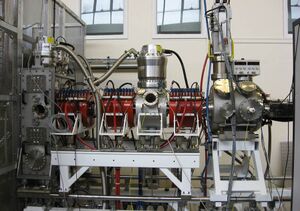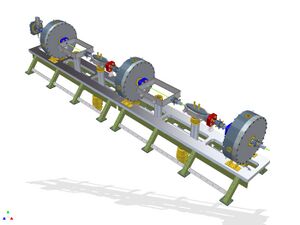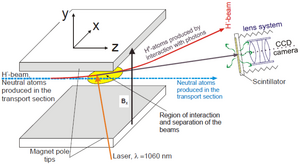Login required
This is the working site for members of the Front End Test Stand (FETS) project.
You must log in to view other pages.
To obtain a login please contact dan.faircloth@stfc.ac.uk
FETS Project Overview
High power short-pulse proton drivers are required for a wide range of applications including neutron spallation sources, neutrino factories, muon colliders, ADSRs and nuclear waste transmutation. In order to generate high power beams, proton drivers typically require multi-turn charge-exchange injection of H− ions into an accumulator ring. The overall deliverable power and quality of the beam is largely determined by the initial accelerating stage of the machine: the 'Front End'. Creating a front end to meet the demands of modern proton drivers is an ongoing challenge in accelerator technology.
For hands-on maintenance of high power proton drivers, the beam-loss-induced radio-activation of components must be kept to a minimum. One of the major sources of beam loss is the trapping of particles in the ring RF buckets. By pre-chopping the H− beam in the linac, trapping losses are considerably reduced. Chopping should be performed at low energy, in the front end, to ease the dumping of up to 40% of the beam. Chopping should also be as quick as possible so there are no partially chopped bunches leaving the linac. A sufficiently quick 'perfect' chopper has yet to be demonstrated world-wide.
The Front End Test Stand (FETS) is an experiment based in building R8 at the Rutherford Appleton Laboratory (RAL). It is a collaboration between ISIS, ASTeC, Imperial College, University of Warwick, University College London and Royal Holloway. This project will design, build and test the first stages necessary to produce a very high quality, perfectly chopped H− ion beam as required for high power proton drivers. The beam parameters are 3 MeV energy and 60 mA beam current at 50 Hz repetition rate and up to 2ms pulse duration. The major components and contact details are detailed below.
Ion Source
- Caesium-enhanced Penning surface plasma H− ion source
- 60 mA pulsed beam current at 50 Hz repetition rate and up to 2 ms pulse length
- 0.25 π mm mrad transverse emittance
Contacts:
| Dan Faircloth | Scott Lawrie |
| STFC ISIS facility | STFC ISIS facility |
| dan.faircloth@stfc.ac.uk | scott.lawrie@stfc.ac.uk |
LEBT
- Three-solenoid magnetic low energy beam transport
- Space-charge neutralised
- 95% transmission
Contacts:
| John Back |
| University of Warwick |
| j.j.back@warwick.ac.uk |
RFQ
- 324 MHz, 4 metre, 3 MeV radio frequency quadrupole
- Vane-type resonating cavity
- Bolted construction
Contacts:
| Alan Letchford | Jürgen Pozimski | Pete Savage | |
| STFC ISIS facility | Joint STFC and Imperial College London | Imperial College London | |
| alan.letchford@stfc.ac.uk | juergen.pozimski@stfc.ac.uk | p.savage@imperial.ac.uk |
MEBT
- Electromagnetic quadrupole and re-bunching cavity medium energy beam transport
- Transport beam through chopper to diagnostics line or rest of accelerator
- Low beam loss and emittance growth
Contacts:
| Ciprian Plostinar | Morteza Aslaninejad |
| STFC ASTec | Imperial College London |
| ciprian.plostinar@stfc.ac.uk | m.aslaninejad@imperial.ac.uk |
Chopper
- Novel separated 'fast-slow' electrostatic deflectors
- Fast chopper rise time <3 ns (between RFQ microbunches): no partially chopped bunches
- Slow chopper pulse rises in gap made by fast chopper
Contacts:
| Mike Clarke-Gayther |
| STFC ISIS facility |
| michael.clarke-gayther@stfc.ac.uk |
Diagnostics
- Non-interceptive
- Beam current transformers & beam position monitors
- Laser photo-detachment emittance scanning
Contacts:
| Christoph Gabor | Stephen Gibson | Simon Jolly | |
| STFC ASTeC | Royal Holloway University of London | University College London | |
| christoph.gabor@stfc.ac.uk | stephen.gibson@rhul.ac.uk | s.jolly@ucl.ac.uk |
Controls/DAQ
- Labview PXI-based
- EPICS distribution
- Fast sampling and calculation
Contacts:
| Gary Boorman | |||
| Royal Holloway University of London | |||
| g.boorman@rhul.ac.uk |






